Search the Special Collections and Archives Portal
Search Results
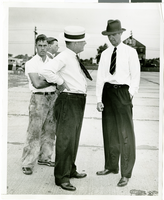
Photograph of Howard Hughes and W.D. "Jim" Guthrive at Roosevent Field, New York, July 18, 1938
Date
1938-07-18
Archival Collection
Description
Handwritten on the back of the image: "Talking to W.D. "Jim" Guthrive at Roosevelt Field. 7/18/38."
Image
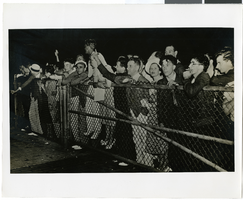
Photograph of a crowd greeting Howard Hughes at Floyd Bennett Field Airport, July 14, 1938
Date
1938-07-14
Archival Collection
Description
The black and white view of a crowd of people gathering to greet Howard Hughes at Floyd Bennett Field Airport in New York. Typed onto a piece of paper attached to the image: "17. Rail birds, part of crowd that waited all nite. International news. (Evening Herald)."
Image
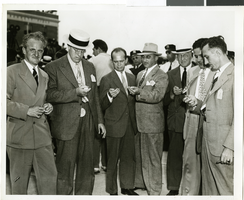
Photograph of a crowd of people awaiting the arrival of Howard Hughes, New York, July 14, 1938
Date
1938-07-14
Archival Collection
Description
The black and white view of members of the Aeronautical Association awaiting the arrival of Howard Hughes and his Lockheed 12 aircraft at the Floyd Bennett Airport in New York. Typed onto a piece of paper attached to the image: "Official timers of Aeronautical Association compare their precision chronometers as Lockheed-14 roars overhead, marking end of Round-the-World flight at Floyd Bennett Airport." Typed onto a second piece of paper also attached to the image: "Official timers of the Aeronautical Association shown at Floyd Bennett Field comparing their precision chronometers as Howard Hughes' plane roared overhead marking the end of his Flight Around The World. July 1938."
Image
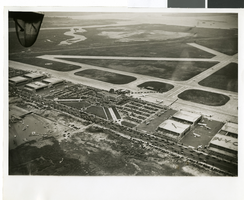
Photograph of the landing of Howard Hughes' Lockheed 14 aircraft, New York, July 14, 1938
Date
1938-07-14
Archival Collection
Description
The black and white, aerial view of Howard Hughes' Lockheed 14 aircraft performing its final landing on the Round the World flight at Floyd Bennett Airport, New York. Typed onto a piece of paper attached to the image: "Journey's End: This airplane view records the end of Howard Hughes' history-making dash around the world in three days, nineteen hours. To the right of the Administration Building at Floyd Bennett Field, Long Island, New York, can be seen the globe-girdling monoplane surrounded by a ring of policemen. The foreground provides an accurate idea of the size of the crowd which stormed the field to welcome home the fliers. Credit Line (ACME)."
Image
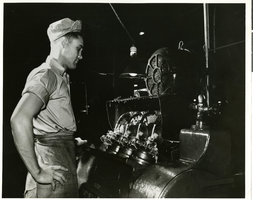
Photograph of a man working on rock bit drilling pieces at the Hughes Tool Co., Houston, Texas, circa 1950s
Date
1950 to 1959
Archival Collection
Description
Transcribed from attached press release: "HUGHES ROCK BIT PRODUCTION more than 500,000 rock bits produced last year by the Hughes Tool Company, Houston, Texas, for drilling the kind of deep wells which now produce 90 per cent of the world's petroleum. The rock bit was invented by Howard Hughes' father and the resulting business became the cornerstone on which Howard Hughes built his industrial empire. The machinist above is performing an operation on the cones which make up the rotating end of the Hughes rock bit." Transcribed from photo sleeve: "The Kearney and Trecker 4 spindle machine at the Hughes Tool Company in Houston, Texas. Ca. 1950s."
Image
Construction of Boulder City, Nevada
Level of Description
File
Archival Collection
Ray Cutright Collection of Winthrop A. Davis Photographs
To request this item in person:
Collection Number: PH-00123
Collection Name: Ray Cutright Collection of Winthrop A. Davis Photographs
Box/Folder: N/A
Collection Name: Ray Cutright Collection of Winthrop A. Davis Photographs
Box/Folder: N/A
Archival Component
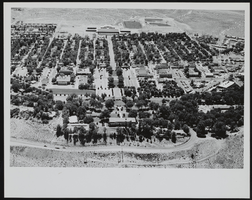
View of Boulder City, Nevada, looking south: photograhic print
Date
1950 (year uncertain; year approximate) to 1955 (year uncertain; year approximate)
Archival Collection
Description
From the Morgan Sweeney Photograph Collection (PH-00228). Aerial View of Boulder City, Nevada, looking south. 1950-55(?).
Image

View of Boulder City, Nevada looking northeast: photographic print
Date
1950 (year uncertain; year approximate) to 1955 (year uncertain; year approximate)
Archival Collection
Description
From the Morgan Sweeney Photograph Collection (PH-00228). Aerial View of Boulder City, Nevada, looking northeast. 1950-55 (?).
Image
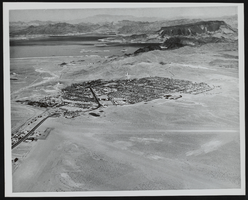
View of Boulder City, Nevada looking northeast: photographic print
Date
1950 (year uncertain; year approximate) to 1955 (year uncertain; year approximate)
Archival Collection
Description
From the Morgan Sweeney Photograph Collection (PH-00228). Aerial View of Boulder City, Nevada, looking northeast. 1950-55(?).
Image
Midway City/Pittman, Nevada
Level of Description
File
Archival Collection
Henderson Public Library Photograph Collection on Henderson, Nevada
To request this item in person:
Collection Number: PH-00254
Collection Name: Henderson Public Library Photograph Collection on Henderson, Nevada
Box/Folder: N/A
Collection Name: Henderson Public Library Photograph Collection on Henderson, Nevada
Box/Folder: N/A
Archival Component
Pagination
Refine my results
Content Type
Creator or Contributor
Subject
Archival Collection
Digital Project
Resource Type
Year
Material Type
Place
Language
Records Classification
